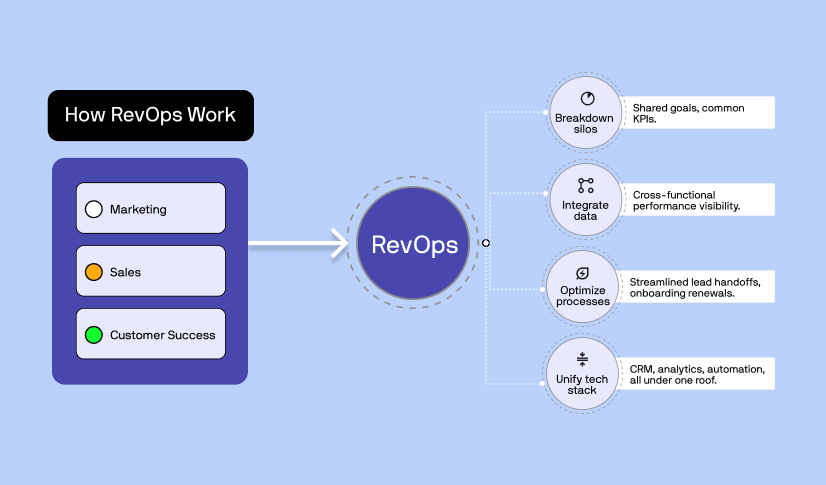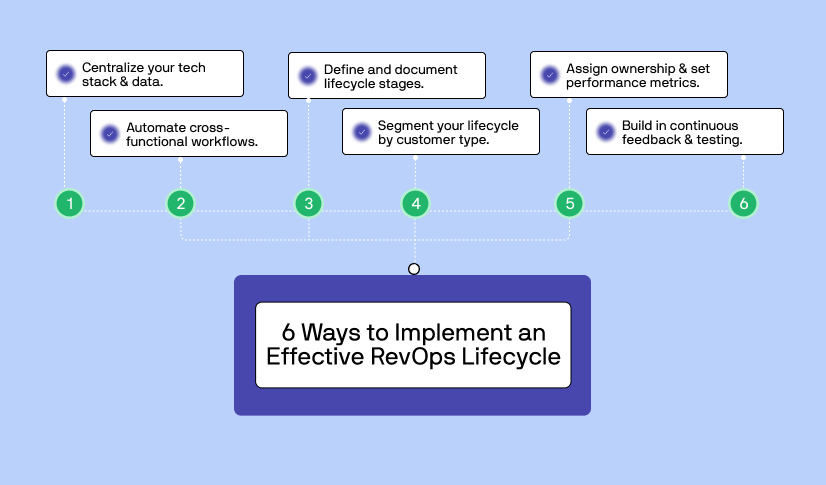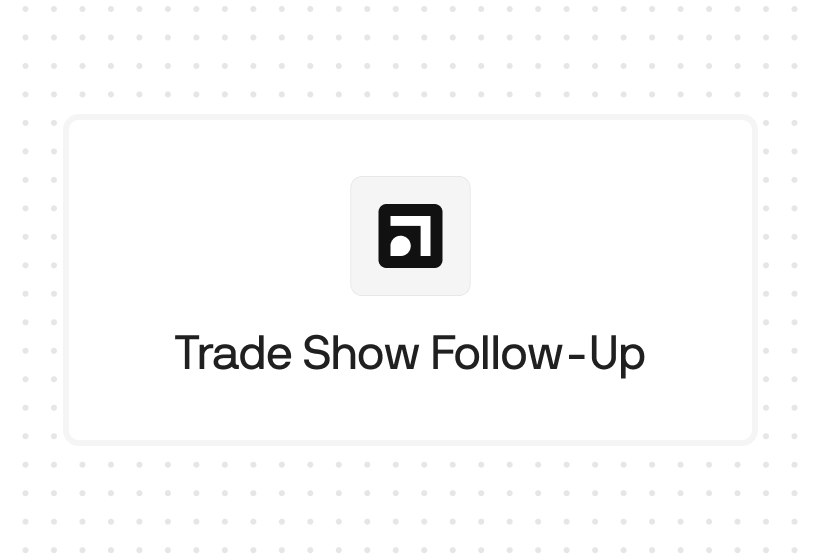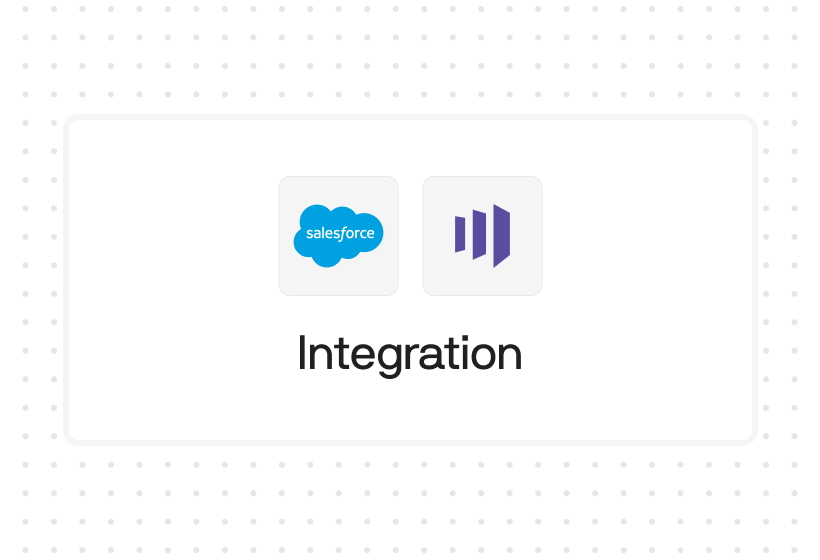Try Default

See how revenue teams automate revenue operations with Default.

Key Takeaways
Key takeaways
- RevOps drives growth by aligning Marketing, Sales, and Customer Success across every stage of the customer lifecycle.
- A unified tech stack, automated workflows, and shared KPIs are essential to avoid revenue leakage.
- Successful RevOps execution requires continuous measurement, cross-functional ownership, and proactive iteration.
- Platforms like Default help RevOps teams centralize data, automate critical transitions, and optimize lifecycle performance at scale.
- Companies that master RevOps grow revenue faster, reduce churn, and create a more seamless customer experience.
Marketing, sales, and success might sit in separate departments — but your customer doesn’t experience them that way.
When teams operate in silos, you see the symptoms everywhere: leads slipping through the cracks, delayed handoffs, misaligned goals, and inconsistent customer experiences. It’s why pipeline stalls and revenue leaks.
RevOps changes that.
By aligning your revenue functions around shared data and processes, RevOps drives growth across every stage of the customer lifecycle — from first touch to expansion and advocacy.
Companies that get it right are seeing the results: Boston Consulting Group found that RevOps can drive a 100–200% increase in marketing ROI, while Forrester reports 300% faster revenue growth for organizations that adopt it.
In this article, we’ll show you exactly how RevOps delivers impact at every stage — with concrete examples and tactics you can apply today.
How does RevOps work?
RevOps isn’t a specific function within an organization. Rather, it’s a process and methodology that aligns and orients existing revenue functions—namely Marketing, Sales, and Customer success—around central goals, objectives, and expectations.
By breaking silos and establishing common KPIs, RevOps ensures the whole organization is rowing in the same direction, and that no one team is undercutting another’s work. Key elements and principles of the RevOps methodology include the following.
Cross-functional alignment
With the sheer volume of resources invested in driving revenue, you don’t want those resources canceling each other out. Marketing, for example, can generate all the leads in the world, but without Sales follow-up, no revenue will come of it. RevOps prioritizes cross-functional alignment to avoid this and similar risks.
Data integration, analysis, & KPI-setting
RevOps teams leverage integrated, cross-functional performance data to maintain team alignment. These integrations also provide holistic insight into how each function actively contributes to revenue. This information is critical not only to assessing performance, but how to fix problems, increase efficiencies, and accelerate revenue growth.
READ MORE: See our comprehensive list of RevOps KPIs and metrics.
Process optimization
As a methodology, RevOps assumes that processes matter as much as, if not more than, individual performance. Processes like lead handoff and customer onboarding, for example, can go wrong when the individual teams don’t have clear standards, practices, and active management—which RevOps provides at every stage of the customer lifecycle.
Integrated technology use
Key to aligning performance and working from a common data foundation is getting everyone to use the same tech stack—CRM, marketing automation, customer support tools, analytics software, etc. Generally, RevOps teams manage these platforms on behalf of the functions they support, guiding all teams toward best practices that maximize their effectiveness.

Lifecycle stages in RevOps
By ensuring smooth alignment and connection across every stage of the customer lifecycle—and across all revenue functions—RevOps teams can decrease dropoff and revenue leakage, which ultimately drives customer acquisition and retention.
1. Awareness
During the awareness stage, prospects aren’t actively looking to buy. But that doesn’t mean they aren’t engaging with your brand. RevOps’s primary objective at this stage is to track as much activity as possible and identify the most impactful ways to:
- Educate prospects on the problem you solve
- Build a sense of urgency around solving the problem
- Provide information on your solution compared to others in the market—whether direct or indirect competitors
- Build brand equity so when they’re ready to buy, they’ll come to you first
CRM setup
RevOps teams should be active in the CRM from Day One, configuring data and workflows to facilitate cross-functional alignment. They also set up and enforce governance processes to avoid data gaps or errors moving forward.
Lead engagement tracking
As much as possible, RevOps teams should track all interactions with awareness-stage leads. For inbound specifically, this requires an early-stage conversion offer to capture their email address, then building a more robust lead profile through data enrichment.
Target account list building
RevOps teams also conduct comprehensive market research and analysis to compile target account lists, build out company and contact records in the CRM, and track their activities within your marketing channels.
2. Consideration
During the consideration stage, buyers are weighing your product against direct and indirect competitors. At this point, Marketing and Sales should be aligned around two common objectives: driving urgency and removing friction.
Often, however, companies build brittle inbound flows that either break or create a high-friction user experience. During this stage, RevOps teams build seamless systems and workflows that prevent lead dropoff and drive engagement. This enables Marketing and Sales teams to drive urgency and make customer needs more acute.
Core objectives at this stage include:
- Creating seamless lead flows that drive leads further along the buying journey
- Targeting leads with relevant messages that speak to their core pain points
- Routing leads to the internal contact best able to respond to their concerns
Automated account assignment
As new accounts come in, make sure they’re assigned to the person best equipped to handle that account. Manual lead assignment is unwieldy at scale, so RevOps teams leverage automated systems to establish predefined criteria for assigning leads to the correct internal contact.
Marketing-sales alignment
RevOps teams also help to drive marketing-sales alignment. The most obvious example is making sure Sales is following up on the leads Marketing generates. Additionally, RevOps can build smart automations that halt lead-gen emails when a lead enters the Sales process, and resume when they leave it.
Lead routing
When a lead downloads a white paper, registers for a webinar, or requests a demo, that’s a sign of high buying intent. It’s critical for Sales to engage that lead as quickly as possible. Even a delay of five minutes can severely hinder your conversion rate.
RevOps teams should set up automated lead routing systems to not only deliver the appropriate content to the lead at the right time, but build follow-up workflows to keep them engaged and drive them toward conversion.
3. Conversion
As deals near the end of the pipeline, you don’t want inefficiencies and poor experiences causing them to fail. What’s more, you don’t want a good experience with Marketing and Sales to turn into a poor experience with Success, reducing the chance of upsell and increasing the chance of churn.
RevOps teams at this stage focus on the following objectives:
- Preventing drop-off during contract negotiation, generation, and signing
- Ensuring seamless transition from Sales to Customer Success
- Empowering the customer with the tools they need to be successful and accelerate the value realized from the product
Contract management
Contract management, like any admin, can decelerate revenue. During the contract management process, RevOps teams can automate contract generation, delivery, and proactively manage the signing process. If there are concerns, RevOps can surface and resolve them quickly.
Onboarding & activation
Once a customer signs the contract, their engagement level is at its peak. RevOps teams need to take advantage by onboarding and engaging them as quickly as possible. For example, automated routing to the appropriate CSM can accelerate product adoption and shorten their path to value.
Monitoring customer engagement
As soon as the customer is won, RevOps teams need to set up systems to monitor engagement—both with customer success teams and within the platform itself. This ensures that when customers slow or drop off, CSMs can step in and identify the issue, reducing the likelihood of churn.
4. Expansion
In addition to driving new business, RevOps teams can help to maximize the revenue from existing customers. This is accomplished in three ways:
- Driving customer satisfaction, reducing the likelihood of churn
- Identifying areas for upsell and cross-sell to increase ACV
- Gather data on customer usage and satisfaction to involve future marketing and sales efforts
New vs. existing business routing
In B2B, new contacts will come in from existing companies, or existing contacts will reengage with marketing content. If you don’t have a way to distinguish between new and existing business, they’ll simply drop into an existing marketing funnel, creating an irrelevant and frustrating experience.
RevOps teams also build automated routing systems to differentiate among new and existing customers, ensuring connection with the right contact and accelerating account onboarding and adoption.
Measuring customer satisfaction
Customer satisfaction, measured through Customer Satisfaction Scores (CSAT), Net Promoter Scores (NPS), or other survey-based metrics, can be excellent gauges for customer excitement and likelihood to renew or advocate for the product.
For RevOps, however, these surveys provide another purpose: feedback for Marketing and Sales. By automating and accelerating satisfaction surveys—especially by conducting them in real-time—the whole organization can ingest feedback and adjust their activities to better align with market expectations.
Automating upsell & cross-sell
Often CSMs want to upsell or cross-sell, but either don’t know how to identify high-intent moments or what to sell. RevOps can leverage data-driven insights to identify and automate upsell and cross-sell opportunities.
For example, a contact visits a feature page for a feature not included in their company’s current package. RevOps teams can automate either internal or external communications to gauge their interest in the feature, and make the path to adding it seamless and fast.
5. Advocacy
Your best marketing resources are your current customers. The quicker they become advocates, the more effective and sustainable your marketing and sales efforts will be.
RevOps teams can add the following value during the advocacy stage:
- Identifying optimal times in the customer journey for referral automation and testimonials
- Ensuring referral data makes its way back to Sales in a timely manner
- Connecting with Marketing to identify and generate testimonials and case studies
Automated referral requests
There are times when customers are more enthusiastic than others. When they’re highly engaged with the product and generating a lot of value, you can send an automated email with a quick referral request. By timing referrals to align with customer journey highpoints, you increase the chance of a positive response.
Generating & routing testimonials
The same goes for generating testimonials—which are critical to boosting brand credibility. RevOps teams can not only generate testimonials, but route them to the appropriate team member to be deployed in marketing and sales campaigns.

Benefits of a well-defined RevOps cycle
1. Consistent revenue growth across all stages
A clearly defined RevOps lifecycle reduces drop-off and friction at every stage — from awareness to expansion. Instead of relying on isolated wins, growth becomes systematized through aligned processes, proactive handoffs, and data-backed decisions. This creates a reliable pipeline that compounds over time, driving scalable and sustainable revenue.
2. Increased operational efficiency
When Marketing, Sales, and Customer Success work from a shared playbook, fewer things fall through the cracks. Teams waste less time chasing misrouted leads, requalifying accounts, or fixing reporting gaps. A structured lifecycle enables automated workflows, clearer responsibilities, and better resource allocation — which means faster execution and fewer internal bottlenecks.
3. Higher customer satisfaction and retention
Lifecycle clarity extends beyond internal gains — it improves the customer experience. With smoother handoffs, faster onboarding, and more relevant engagement, customers feel guided rather than bounced between teams. That builds trust, speeds up time-to-value, and reduces churn — while setting the stage for upsells, referrals, and long-term advocacy.
4. Better forecasting and decision-making
A well-run RevOps lifecycle generates clean, centralized data — the kind leadership needs for forecasting and strategic planning. With visibility into conversion rates, velocity, and dropoff patterns at each stage, leaders can make faster, smarter decisions around spend, headcount, and growth initiatives. The result: fewer blind spots and more confidence in go-to-market strategies.
5. Easier tech stack consolidation and automation
A defined RevOps lifecycle makes it clear which tools are actually needed at each stage — and which are redundant or disconnected. This simplifies tech stack decisions and makes it easier to automate high-friction processes like lead routing, onboarding, and upsell workflows. The result is lower overhead, less complexity, and a stronger foundation for scale.

Default helps RevOps leaders operationalize every stage of the customer lifecycle — with unified data, automated workflows, and a streamlined tech stack.
Want to see how? Book a quick demo to explore Default in action.
Challenges in managing RevOps lifecycle stages
Even with a strong strategy in place, maintaining an effective RevOps lifecycle isn’t easy. Growth pressure, evolving customer expectations, and operational complexity create friction at every stage. Here’s where most organizations struggle — and why solving these challenges requires more than manual effort.
1. Disconnected systems and data silos
When marketing, sales, and success teams rely on separate tools, data becomes fragmented. Critical lifecycle insights (like conversion rates, onboarding health, or upsell triggers) are trapped in isolated systems, making revenue leakage harder to spot. The best RevOps software, like Default, that connects these touchpoints ensures clean, real-time data visibility across the full customer journey, not just isolated stages.
2. Inefficient handoffs between teams
Without strong process governance, handoffs between teams become high-risk points. Leads get misrouted, follow-ups lag, and customers experience inconsistent messaging. Over time, this breaks trust and slows momentum. Automating handoff workflows and embedding clear ownership rules at each stage of the lifecycle reduces human error, keeping customers moving smoothly toward value realization.
3. Difficulty tracking engagement across the full journey
Most organizations can track top-of-funnel activities, but engagement deeper into the lifecycle — onboarding milestones, expansion interest, advocacy signals — often goes unnoticed. This blind spot results in missed upsell moments and preventable churn. Lifecycle-focused platforms surface these engagement signals in real time, helping teams act quickly when high-value opportunities or risks emerge.
4. Reactive rather than proactive problem-solving
Disconnected or delayed data forces teams into reactive mode, responding to lost deals, churn, or negative feedback (after the damage is done). It’s a costly way to operate — both financially and competitively. With unified lifecycle data and performance metrics, RevOps teams can spot early warning signs, intervene proactively, and shift from firefighting to strategic growth management.
How to implement an effective RevOps lifecycle
Rolling out an effective RevOps lifecycle isn’t about just aligning teams — it’s about building the systems, automations, and data foundation that make alignment inevitable. Here’s how to do it.
1. Centralize your tech stack and data infrastructure
The first move isn’t strategy — it’s systems. Unify your CRM, marketing automation, customer success tools, and analytics under a shared infrastructure. Default is built to do exactly this: integrate key platforms and clean up fragmented data. Once your systems speak the same language, teams can act on shared insights instead of conflicting dashboards.
2. Define and document lifecycle stages
It’s surprising how many GTM teams don’t align on where awareness ends and consideration begins — or what “activation” really means. Define each stage explicitly, along with its entry/exit criteria. Default helps formalize these definitions through custom workflows and engagement tracking, so teams can move prospects forward using clear, shared benchmarks.
3. Automate cross-functional workflows
Manual handoffs are where momentum dies. Use Default to automate critical lifecycle transitions — from lead routing and demo scheduling to onboarding and renewal sequences. Automations should be behavior-based, trigger-driven, and include fallback scenarios to prevent dropoff. The goal: eliminate friction, not just reduce it.
4. Assign ownership and set performance metrics
Every stage of the lifecycle should have a clear owner, a defined SLA, and shared KPIs. Without this, even the best systems fail. Default connects actions to outcomes by tying activities to metrics like conversion velocity, onboarding time, and upsell rates — giving RevOps leaders visibility into what’s working and what’s not.
5. Segment your lifecycle by customer type
Not all customers move through the lifecycle the same way. Use Default’s segmentation capabilities to create dynamic lifecycle paths based on firmographics, behavior, or product usage. This allows for tailored messaging, more accurate forecasting, and tighter prioritization — especially when balancing high-touch vs low-touch motions.
6. Build in continuous feedback and testing
A RevOps lifecycle isn’t static. It should evolve based on customer behavior, GTM shifts, and team feedback. Use tools like Default to surface friction points automatically — whether it’s onboarding dropoff or stalled expansions — and test process changes continuously. The faster your feedback loops, the faster your lifecycle improves.

Best practices for optimizing RevOps lifecycle stages
Building a RevOps lifecycle is only the beginning. The real leverage comes from refining it continuously. These are the operational habits and structural best practices that top-performing RevOps teams adopt to keep lifecycle performance strong and sustainable:
- Align goals and KPIs cross-functionally:
Make sure Marketing, Sales, and Success aren’t chasing different outcomes. Set shared KPIs for each lifecycle stage (from lead quality to onboarding velocity to expansion revenue) and review them together. When every function is measured by the same success criteria, alignment becomes automatic and siloed decision-making disappears. - Measure success at each stage:
Don’t wait for lagging indicators like missed targets or churn. Define 2–3 high-signal metrics for each stage — think demo-to-close velocity, activation rate, CSAT, and referral volume. Review performance regularly and track over time so you can catch drop-offs early and proactively test improvements. - Automate for speed and consistency:
Handoffs, follow-ups, and onboarding shouldn't rely on someone remembering to do them. Use automation to route leads, assign accounts, and trigger workflows based on customer behavior or lifecycle stage. Platforms like Default help teams reduce human error and speed up the entire journey without sacrificing personalization. - Keep your data clean and real-time:
Every lifecycle playbook breaks down if your data is unreliable. Enforce strong data governance: eliminate duplicates, standardize enrichment fields, and align definitions across tools. Default’s unified platform ensures that teams aren’t guessing — they’re operating from a shared source of truth that updates in real time. - Iterate based on customer feedback loops:
Quantitative data tells you what’s happening; feedback tells you why. Collect quick feedback at key moments — post-onboarding, pre-renewal, after upsells — and review it cross-functionally. Use these insights to refine lifecycle messaging, adjust sequences, and resolve friction before it escalates into lost revenue. - Invest in enablement and governance:
Even the best-designed lifecycle needs people to run it well. Build internal playbooks, train team leads on expectations and service-level agreements (SLAs), and establish a RevOps governance group that oversees lifecycle integrity. This prevents process drift, ensures your systems scale with the business, and keeps every team aligned as you grow.
Simplify your Revenue Operations with Default
Because of its cross-functional approach, RevOps adds value throughout the entire customer lifecycle. Although this is obvious in theory, in practice it requires automation and seamless integration across Marketing, Sales, and Success—which is difficult when everyone is using disconnected point solutions.
Default automates lead conversion, routing, scheduling, and engagement tracking across the entire customer lifecycle. It is the unified platform that RevOps teams need to avoid data leakage and customer dropoff.
See how you can unify your RevOps tech stack with one simple decision. See Default in action today.
Conclusion

Building Default to help the next 10 million B2B companies grow from zero to IPO better, faster, and cheaper.
Accelerate your growth with Default.
Revamp inbound with easier routing, actionable intent, and faster scheduling















.png)








%201.svg)



.svg)





%201.svg)



%201.svg)

